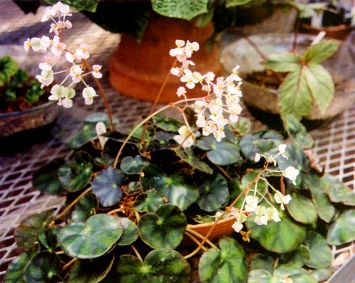B. hydrocotylifolia Otto ex Hooker was discovered in Mexico in 1841, but was not described until 1949.
B. hydrocotylifolia is a rhizomatous begonia with a short thick succulent and creeping rhizome. The leaves are small, 3 by 2 1 /2 inches, orbicular(circular), cordate (heart shaped), entire, coriaceous (leathery), glabrous dark green in color, medium green in shading and when young covered with hairs. The underside of the leaf is light red and lightly napped. The brownish green petioles are 1 1/2 to 3 inches long and keep the plant compact.
Flowers are small rose pink with two rounded petals on both the male and female. The fruit has three nearly equal wings. Blooms are profuse mid-winter to early spring.
B. hydrocotylifolia is sometimes called pennywort or pond lily begonia because of its appearance. It is in fact one parent of B. `Erythrophylla’ which is also called pond lily.


